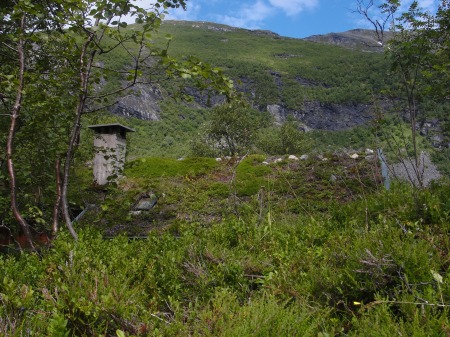A stave church, or stavkirke, is a timber church with a structural framework of timber staves (beams) resting on timber sleepers and carrying timber wall plates. The wall frames are infilled with vertical planks.

Borgund stave church
The exterior varies from simple and rough-hewn to painstakingly ornate, and in size the churches range from small, shed-like structures – such as Haltdalen stavkirke – to the more imposing Heddal stavkirke, which is the largest of its kind still standing. (At the end of this post, you will find the legend of how the latter was built in only three days.*)
In medieval Norway, the stave frame was the prevalent construction method for churches. There were at least a thousand of them – some sources say as many as two thousand – the length and breadth of the country, built in the 12th and 13th centuries. But by 1650, most of them had disappeared. Following the devastation wrought by the Black Death, many churches fell into disrepair, whilst the Reformation brought a change in the construction, style and use of churches.

Tarred pine shingles clad the steep roof sections
Today, only 28 of the original stave churches remain. Set on stone foundations, the rest of the buildings are entirely made from wood; from the dowels to the roof shingles. It is amazing to see how well some of them have lasted.
The best preserved is Borgund stavkirke in the county of Sogn og Fjordane, in which most of the existing structure consists of original timbers.
Built from pinewood between 1180 and 1200, it is a striking, darkly ornate structure at the heart of a lush valley. I took the pictures in this post when I visited Borgund last August.

From the interior. In places, rune inscriptions can still be seen.
The intricate carvings, small-format shingles, and black dragons’ heads craning their necks from projecting gable apexes, are miles away from the simple, neutral style we tend to associate with Scandinavian architecture.
Through the centuries, stave churches were preserved by covering the timber in tar. When I visited this summer, the church had just been freshly tarred, making the external wood even darker than normal and lending it a rich, warm scent in the sun.

The external gallery, freshly tarred
The magnificent detailing and impressive longevity of it all made me think of the immense contrast between the church itself and the bleak, sparse living conditions of the people who built it. For farmers and craftsmen eking out a living in a remote Norwegian valley, building such a structure must have been an immense undertaking.

Medieval carvings, beautifully preserved
* There is an old legend about the building of Heddal stave church.
A local farmer, Raud Rygi, wanted to have a new church built. A mysterious stranger came along and offered to do the impossible: to build the church in only three days. His fee for this task was one of three things: either the farmer would have to fetch him the sun and the moon out of the sky, hand him his own heart on a plate, or guess the stranger’s name. Unsurprisingly, Raud chose the third option. He thought he would have plenty of time for name-guessing, as surely nobody could build a church in three days…
However, on the first night, the materials were already in place. On the second night, the steeple was raised. Despairing, and with only one day left before the church would be complete, Raud wandered round the building site at dusk. Suddenly, he heard a haunting voice rising out of the mountain, singing a lullaby: “Hush now, little one, tomorrow Finn will bring you the moon, the sun, and Raud’s heart for you to play with…”
Riddle solved: the builder was Finn, the troll. Raud Rygi’s life was saved, and Heddal had its new stave church.

Runic inscriptions on a church wall

The Old King’s Road, leading up to Borgund stave church








![539364_10151138438521263_2049127717_n[1]](https://esibuilding.files.wordpress.com/2013/02/539364_10151138438521263_2049127717_n1.jpg?w=450&h=600)
![523361_10151136216591263_1724108904_n[1]](https://esibuilding.files.wordpress.com/2013/02/523361_10151136216591263_1724108904_n1.jpg?w=450&h=600)
















